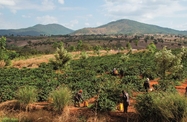Smallholder rice farmers in the Iringa and Morogoro regions of Tanzania are set to benefit from new agricultural programmes to strengthen post-harvest management skills and expand commercial value chains.

Three projects in total were announced in February 2018 by representatives of the EU, Ministry of Agriculture and participating organisations, with the schemes to receive a total of €4.5m in financing from the EU.
One of the initiatives, taking place in Iringa, is being implemented by the UN’s Food and Agriculture Organisation (FAO), in hand with the Ministry of Agriculture. The plan is expected to reach over 10,000 farmers and focus on controlling post-harvest losses through the application of proper, affordable storage. The ultimate goal is to ensure food security at harvest, as production losses in the value chain are rare beyond the farmer level, according to the FAO.
Meanwhile, development organisation HELVETAS Swiss Intercooperation is leading another scheme in the Morogoro region. The three-year project targets female and young smallholder farmers and focuses on good agricultural practices, marketing, access to financial services and post-harvest infrastructure in the rice segment. As with the FAO project, providing crop storage facilities is of particular importance.
A second Morogoro scheme is a collaboration between the Rice Council of Tanzania and the Aga Khan Foundation, an international development agency. It will educate up to 5000 farmers, particularly women and youth. This project’s broader aim is to strengthen the production capacity of small-scale rice farmers.
The three initiatives fall under the Southern Agricultural Growth Corridor of Tanzania (SAGCOT) programme. SAGCOT is a multi-project, public-private partnership that was launched in 2010 with the goal of leveraging economies of scale and expanding smallholder access to markets, services and agro-inputs along the southern transport corridor.
As of mid-2017 SAGCOT had generated $566m in investments, and the government is looking to mobilise $3.5bn in total by 2030.
Constraints on productivity
Initiatives such as these will be welcomed by the agricultural industry, as productivity gains still hinge on addressing historical hurdles. Speaking on the HELVETAS project, Steven Kebwe, the Morogoro regional commissioner, noted the obstacles facing the rice segment. These include smallholder dependency on rainfall, underdeveloped irrigation infrastructure and limited access to affordable financial services.
Poor storage and processing facilities, as well as weak value chains, are also partly responsible for high post-harvest losses. According to Roeland van de Geer, EU head of delegation to Tanzania and the East African Community, such losses can account for up to 40% of all rice harvest volumes.
Other factors challenging modernisation efforts include a lack of widespread provisioning of agro-inputs. In March 2018 the government announced a goal of procuring 200,000 tonnes of fertilisers for farmers this year, a 100% increase over 2017.
A recent World Bank report ranked Tanzania 37th out of 62 economies on the document’s fertiliser index, scoring 52.84 out of 100. The index measures fertiliser registration, quality of fertiliser in the market, and the requirements for importing fertiliser.
Tanzania ranked higher on the index for seed (17th place with a score of 68.91) and finance (5th place with a score of 84.85).
Smallholders critical to performance of Tanzanian rice segment
Given that nearly 75% of the planted area for rice in Tanzania is tended to by smallholder farmers under rain-fed conditions, according to the US Department of Agriculture (USDA), the Iringa and Morogoro plans, if successful, could have a significant impact on the sector. Indeed, according to a recent USDA report, the average yield for smallholder rice farmers could be much higher.
Output at small-scale farms currently ranges from 1.6 and 2.4 tonnes per ha, though when plots are irrigated they can produce 4-10 tonnes per ha, depending on the land, seed varieties and management practices.
With the total land area dedicated to rice cultivation forecast to remain flat in the 2018/19 marketing year, according to the USDA, and the “The Rice Value Chain in Tanzania” 2015 report by the FAO estimating that rice demand would triple by 2020, efforts to foster better post-harvest management practices and improve efficiencies would appear to be well timed.


